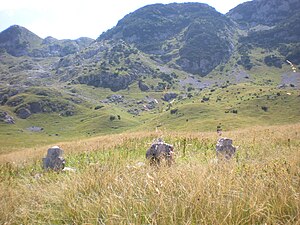Third anti-Partisan Offensive
| Operation Trio | ||||||||
|---|---|---|---|---|---|---|---|---|
| Part of World War II in Yugoslavia | ||||||||
 Tito and the main force of the Partisans withdrew into the Zelengora ("green hill") mountains to escape the Axis offensive |
||||||||
|
||||||||
| Belligerents | ||||||||
|
|
|
|||||||
| Commanders and leaders | ||||||||
| Units involved | ||||||||
|
Unknown |
|
||||||
| Strength | ||||||||
| around 4,000 men | ||||||||
| Casualties and losses | ||||||||
|
|
|
||||||
Operation Trio (Serbo-Croatian: Operacija Trio) was the first large-scale joint German-Italian counter-insurgency operation of World War II conducted in the Independent State of Croatia (NDH), which included modern-day Bosnia and Herzegovina. It was carried out in two phases within eastern Bosnia from 20 April to 13 May 1942, with Ustaše militia and Croatian Home Guard forces taking part on the Axis side. The aim of the operation was to target all insurgents between Sarajevo and the Drina river in eastern Bosnia. These included groups led by communists and Serb nationalist Chetniks. Differentiating between the of the two insurgent factions was difficult, as even the communist-led insurgent groups consisted mainly of Serb peasants who had little understanding of the political aims of their leaders.
Operation Trio consisted of two parts, Trio I and Trio II. Together they comprised one element of the Axis effort known as the Third Enemy Offensive (Serbo-Croatian: Treća neprijateljska ofenziva) in post-war Yugoslav historiography. The joint Italian-Chetnik offensive in Montenegro and eastern Herzegovina formed the other element. The Third Enemy Offensive forms part of the Seven Enemy Offensives framework in Yugoslav historiography.
...
Wikipedia
